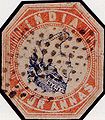Cut to shape
Cut to shape is a philatelic term referring to a postage stamp or postal stationery indicium (printed stamp image) that has been cut to the shape of the design, such as an octagon, circle or oval, instead of simply cut into a square or rectangular shape.[1]
Stamps cut to shape almost always command a lower price than those cut square, and sometimes have little or no value, especially envelope indicia cut to shape. Although many stamps unfortunately have been cut to shape by stamp collectors, some early stamps were produced without perforations and were often cut to shape by people before they affixed the stamps to their envelopes. This is true, for example, for the octagon-shaped 4 Annas stamp of India issued in 1854, which is most commonly found cut to shape on envelopes or pieces.
-
India 1854, cut square
-
India 1854 (inverted head), cut to shape
All of the surviving examples of the India 1854 (inverted head) are postally used. Only two (or three) are known cut square; another 24 or so are cut to shape (that is, in an octagonal shape). One from the collection of the Earl of Crawford was exhibited in the World Philatelic Exhibition in Washington in 2006.[2]
The "world's most famous stamp" — the unique 1856 British Guiana 1c magenta — is cut into an octagonal shape. Consequently, it has been referred to as being cut to shape,[1] although technically that term is incorrect as the stamp design is rectangular in shape.
References
- ^ a b "Glossary Of Philatelic Terms". Linn's Stamp News. Archived from the original on 2008-05-21. Retrieved 2008-10-15.
- ^ India's 1854 Blue and Pale Red Inverted Head


